SUMMARY
This is AI generated summarization, which may have errors. For context, always refer to the full article.
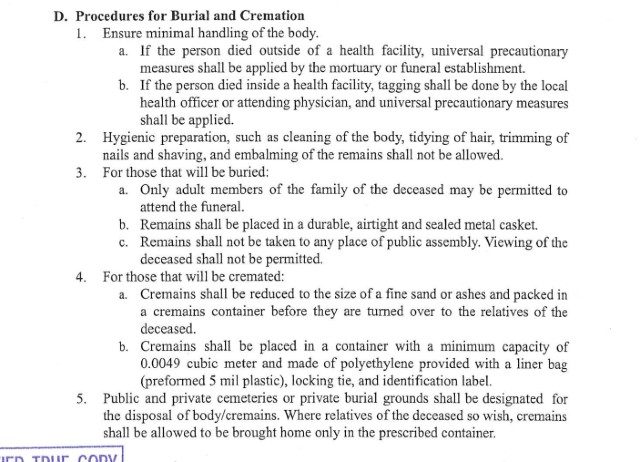
MANILA, Philippines – Ren (not his real name)* woke up on March 22 thinking it would be another day under lockdown, until his phone rang at almost 11 am.
At the other end of the line was a Pasay hospital nurse, informing him of his 77-year-old father’s death. He had 4 hours to retrieve the body, the nurse reminded him.
Ren’s father, at the time of his death, was only a patient under investigation (PUI). He was tested two days before his death, and the results, which turned out negative, were released only on April 8.
Desperate to meet the deadline, Ren and his brother defied the lockdown and braved the streets of Pasay City to find a funeral home that would assist them. They approached at least 3, only to be turned down by all.
Ren said they were asked each time: What was the cause of death? They answered with what they knew then: something about the lungs. There were no test results yet, after all.
“Kapag sinabi mo na anything related sa lungs o sa respiratory ang ikinamatay, ayaw nila (If you told them that the cause of death was related to the lungs, they would refuse.),” he told Rappler.
After a few calls, the city government eventually provided a closed van to transport his father to a local crematorium, complete with an attendant who wore personal protective equipment (PPE).
At 5 pm, the hospital released his father’s body, already disinfected, inside a tightly-wrapped black cadaver bag, following protocols set by the Department of Health (DOH).
Ren last saw his father on March 20, when he was admitted to the hospital, and when they thought things would turn out just fine. It turned out that it would be the last time he would ever see his father’s face, as protocols also prohibit the opening of cadaver bags after they are sealed.
The van carrying his father’s body then rushed to the city crematorium, bracing for the long line. The process felt mechanical and was devoid of emotions – a tell-tale sign that Ren’s father wasn’t the first body they handled, nor would it be the last.
Ren’s emotionally draining day ended at almost 7 pm. He almost forgot to grieve. If things weren’t as bad as they were now, his extended family would be there to help handle things.
“Iyong gusto mo na umiyak, gusto mo na ilabas lahat, kaya lang, kapag ginawa mo iyon at that time, masyado ka manghihina at maaawa sa sarili mo at mawawalan ka ng oras para ayusin iyong dapat ayusin,” he said.
(You want to cry, you want to release everything, but you know that if you did that at that time, you’d just be devoid of energy and drown in self-pity. You’ll just lose time you’re supposed to use fixing what needs to be fixed.)
“Ganoon na siya kahirap, paano kung mahina rin ang maiwan? Ayoko na mangyari pa sa iba iyong ganitong pangyayari na aligaga ka sa paghahanap,” Ren added.
(If it’s that hard, how would it be if the one left behind were weak? I don’t want this to happen to anyone else, being so stressed out searching.)
Accommodate all if they could
Ren’s experience isn’t unique, nor will it be the last account the public will hear about a frantic search for funeral homes in the face of the coronavirus pandemic. In fact, the cremation of the first person who died of the coronavirus in the country, a 44-year-old Chinese man, was delayed for so long after funeral operators kept backing out.
Under normal circumstances, a deceased person’s kin only has to contact any of the funeral homes in the city and they would surely get one fast. But the coronavirus pandemic – even for PUIs – has made things harder for many.
If it was only up to Jon (not his real name)*, a manager at one of Pasay City’s well-known funeral homes, they will accommodate every family that needs them.
It is the job they know best and which puts food on the table, especially at a time when many workers in Luzon and neighboring provinces face uncertainty due to the lockdown.
Jon spends his days juggling administrative work, making sure that protocols are followed, and that his personnel are safe. His tasks also include talking to families, and in some cases, breaking the news to them that they cannot be assisted.
“Gugustuhin man namin na kunin lahat, may hangganan din iyong kakayanan namin (Even if want to accept all, we have our limits),” he told Rappler in a phone interview.
Jon’s funeral home offers one of the cheapest rates in Metro Manila, with services as low as P20,000, excluding the cremation fee. In the past 3 weeks, he said they were able to handle 30 bodies already, including many who died as PUIs.
But regardless of the cause of death, they treat each body as a confirmed case. The bodies all end up in the same morgue in some hospitals and may have been exposed to the virus, Jon explained.
Taking risks is not an option, especially for them whose jobs are essential in a crisis.
“Iyong iba umiiwas sa danger na mahawa sa virus. Ganoon din kami syempre kasi may mga pamilya rin kami,” he said. “Pero trabaho namin ito, hindi naman puwedeng tumalikod kami, pero sana i-consider iyong issues namin.”
(Others are avoiding the danger of getting infected with the virus, Same thing with us of course because we also have our families. But this is our job and we cannot turn our backs on it, but I hope they consider our issues, too.)
His personnel tapped their “common sense” to learn how to handle bodies in the time of the coronavirus. They also wear personal protective equipment (PPE), like the ones worn by medical frontliners, even if it feels suffocating because of the heat.
“The first two weeks super challenging kasi unang-una, hindi tayo trained na mag-handle kasi wala tayong masyadong equipment,” he said. “Doon ka lang matututo sa naririnig mo sa radyo o nababasa mo sa balita, o kaya common sense na lang pairalin mo, protektahan mo na lang sarili mo.”
(The first two weeks were very challenging because first of all, we were not trained on how to handle such cases because we did not have enough equipment. You just learn from what you hear on the radio or read in the news, or you use your common sense and just protect yourself.)
Long lines at Pasay City’s own crematorium
Limited resources sometimes hinder funeral homes from offering their services to families, even if they want to. The strict protocols, along with the unavailability of crematoriums, take so much out of their time and resources.
For example, the guidelines set by the DOH are clear: it is the responsibility of the funeral establishment to provide for the transport of remains to the crematorium. Funeral parlors are also expected to pick up bodies from the hospital as protocols state that bodies should be transferred to the mortuary “as soon as possible after death.”
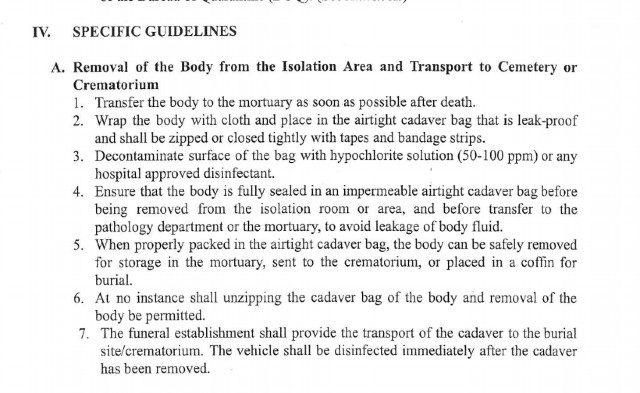
But not many funeral homes, especially small ones that cater to the city’s indigent, operate with a huge fleet of vehicles, according to Jon.
The already small number of vans owned by Jon’s funeral home are often always out of the garage and stuck waiting for their turn at the city’s public crematorium. This is one of the main reasons why they decline some families asking for their services.
This is the same experience of other funeral homes in Pasay City. Rappler called and inquired with two establishments in the city and was told, on background, that it might take a while for a family to be accommodated because their service vehicles had already been dispatched to the crematorium.
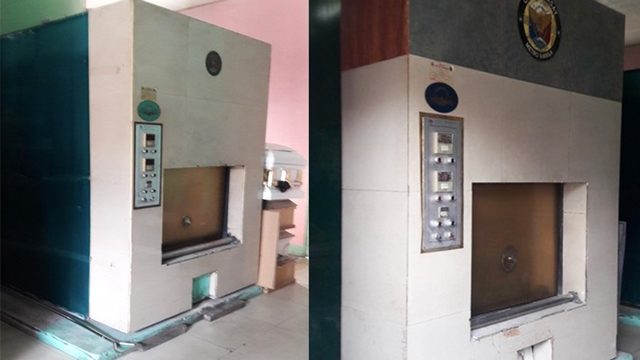
The Pasay City Public Cemetery, located along Sarhento Mariano Street, is where most of the city’s indigent residents are buried in tall apartment-type tombs scattered all around the 3.33-hectare lot.
In between the narrow alleys are makeshift shelters made of scavenged wood, home to hundreds of poor families. It is common to find children playing in different parts of the cemetery.
But these days, the small roads are occupied by parked vehicles and their respective attendants, all lined up for the crematorium. White vans marked as ambulances also stream in and out of the cemetery. A couple of families sometimes wait under a shade, a refuge from the blistering heat of the sun.
The Pasay City Crematorium is one of the few facilities supported by a local government unit in Metro Manila. Cremation costs P15,000 for non-Pasay residents, P8,000 for residents, and P3,000 for indigents.
Deceased persons found to be positive for the coronavirus, however, can be cremated free of charge.
The rates are far cheaper than the services offered by private crematoriums, which can range from P70,000 to P100,000. (READ: The cost of dying in the Philippines: Can you afford it?)
According to Jun Burgos, chief of the Pasay City public information office, the facility has already cremated at least 246 bodies since March 15. This translates to an average of 6 to 8 bodies a day.
Out of this number, only one was COVID-19 positive while the rest were “mostly PUIs and persons under monitoring.”
Before the outbreak started, the queue at the Pasay City Crematorium usually took 2 to 3 hours at the most, with most of the time allotted for cremation of the body.
Now, attendants can expect to line up for hours or be placed on the waiting list, even if they started so early in the morning. Jon’s employees often had to go to the cemetery and take the place of a colleague whose shift ended while waiting in line.
“Minsan lubog na ang araw, nakapila pa rin, pupuntahan na lang siya para marelyebo,” he said.
(Sometimes, they are still in line even by sunset. Another employee just comes to relieve them.)
But they have to see every process through, as any good worker will do, even if it means spending the whole day there. After all, they have to follow the DOH rule that bodies should be cremated within 12 hours of death.
As much as possible, Jon does not want to reject families. But he acknowledges that he has to make sure his funeral home performs efficiently, given that the severity of the coronavirus situation in the coming weeks remains to be seen.
For now, he hopes the DOH and LGUs listen to their recommendations, including coming up with a system where bodies are properly distributed across funeral homes.
He also hopes there will be an adequate number of vehicles in each LGU – not even ambulances, just closed vans to transport bodies – so that families do not need to frantically search for help in moments when they should be grieving for their departed loved ones.
“Hindi naman dapat nag-decline pero paano if hindi na kaya (It’s wrong to decline, but what if we really can’t handle anymore)?” Jon said.
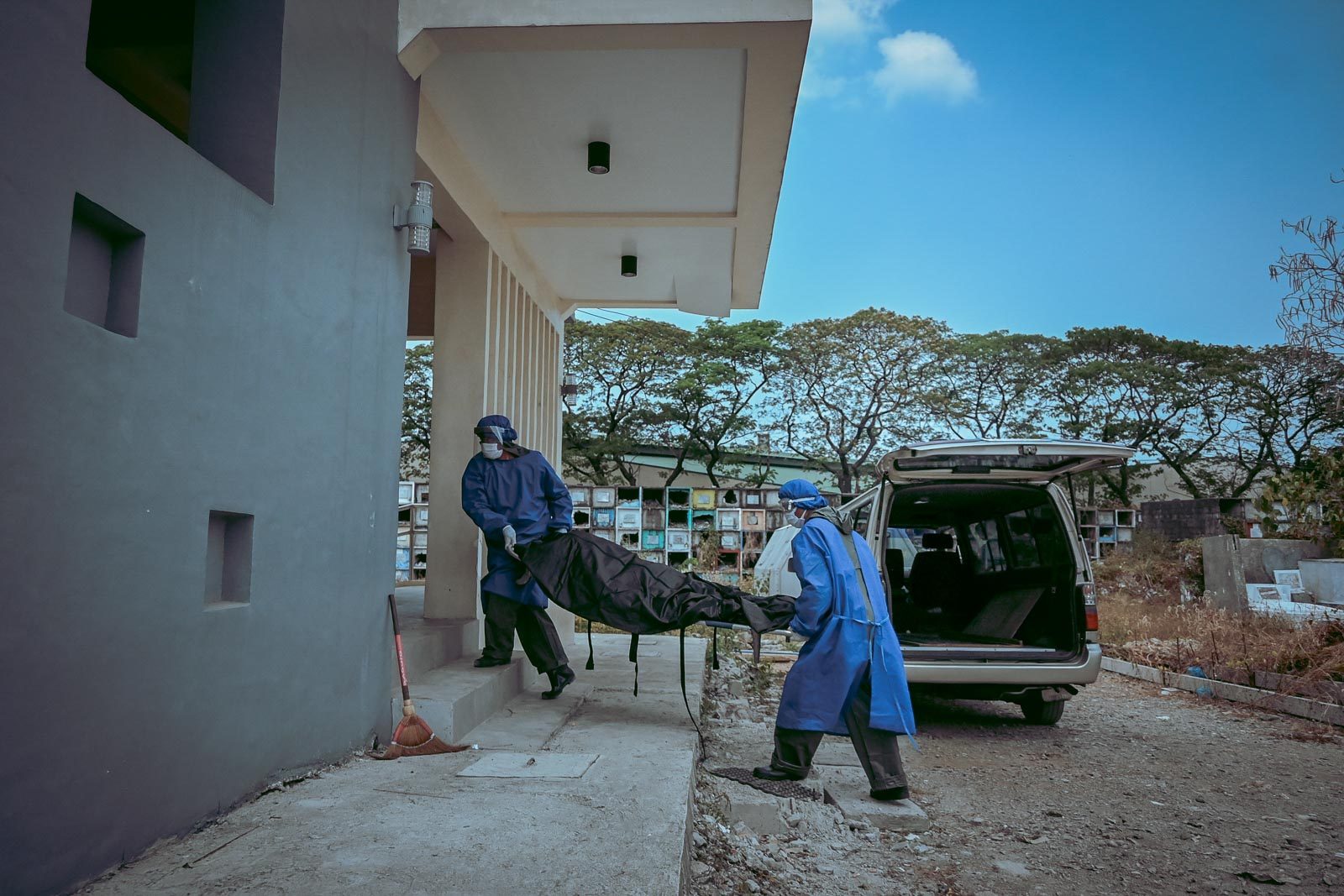
Extra caution
The Dayao Funeral Home in Quezon City has been operating for almost 74 years now. It opened in 1946 and is one of the first funeral homes in the city.
Pablo Dayao has been overseeing the operations of their sole branch for decades. A licensed embalmer, he attended a funeral service program abroad while he was on active duty in the United States navy.
The Dayao Funeral Home is one of the funeral homes tapped by the Quzon City local government to handle cadavers during the pandemic. In the past 3 weeks, the Dayao Funeral Home already took care at least 10 bodies, including two COVID-19 cases.
Dayao, the secretary-general of the National Federation of Mortuary Stakeholders, said he’s not afraid, given his extensive background. But they treat each body as a coronavirus-related case regardless of the cause of death.
Before they take in a body, Dayao said, he asks for clearance from the hospital or a death certificate to confirm the cause of death. There are families who reportedly don’t reply when he asks for these requirements.
“Kung itatago mo sa akin iyan, hindi natin pinangangalagaan ang sangkatauhan natin,” he said. “Huwag tayo magmadali at dapat gawin natin iyong proseso para tayo lahat ay ligtas dito sa sakit na ito.”
(If they’re going to hide it, they are not protecting themselves and the people around them. They should not rush, instead we should follow the right process so everyone can be safe from this disease.)
He admitted that this might look like he’s declining some families, but it’s for their own good.
“Marami sana siguro kaming ma-process na pero naniniguro kami kasi gusto namin ma-process nang maayos ang patay (We could’ve processed a lot more already but we want to make sure we process every dead body correctly),” Dayao added.
When they are able to confirm details and are ready to pick up, Dayao’s men wear their PPEs – which include two gloves, a poncho-like suit, and masks – and carry their own disinfectant kits to the hospital.
They disinfect every step of the way: Before they place the cadaver bag inside the van, upon arriving at the Baesa Crematorium, and when they are done with their task.
Before leaving the crematorium, the attendants remove their outer PPEs and put them in the designated trash bags at the crematorium, according to Dayao.
Upon arrival at their office, his men go through another set of processes. They have to first wash their hands and face with soap, remove their clothes, and take a hot bath.
After all these are done, the attendants then start a 14-hour “self-isolation” in one of the unoccupied chapels of the Dayao Funeral Home, before going home to their respective families.
Dayao said that the process he implemented for his workers may look exhausting and often dents his already slim manpower – reduced to almost only two attendants and one driver per shift due to the lockdown.
But these are still necessary because letting their guards down is risky in the face of a deadly crisis, especially since they still go home to their families. Miss a step and one risks not following the rest, exposing themselves to the dangers of the virus.
“Importante iyong ganito kasi hindi mo naman alam talaga kung ano ang puwedeng mangyari (These are all important because you really don’t know what might happen),” he said.
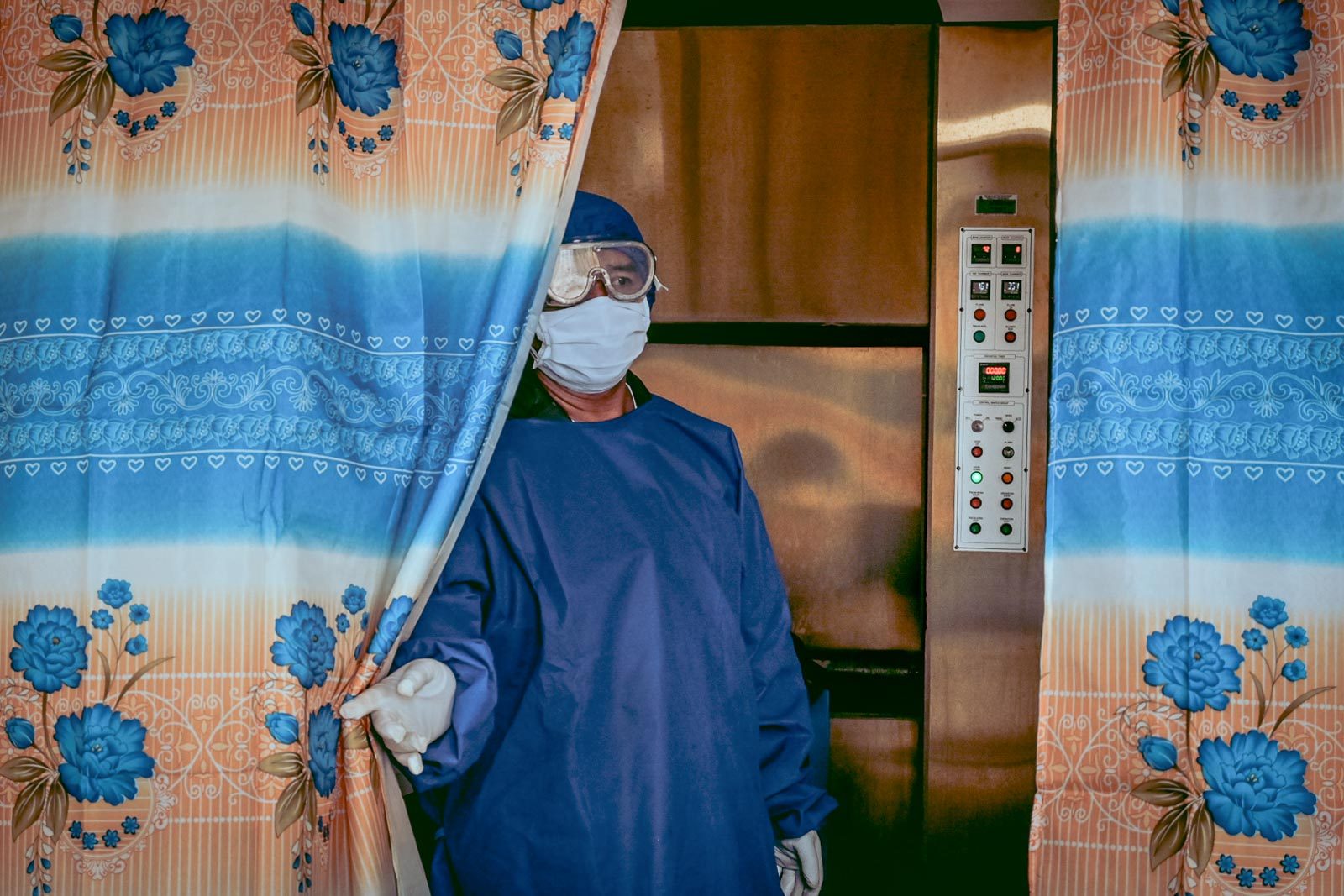
Help brace for coming weeks
The Baesa Crematorium stands out in a sea of apartment-style tombs inside a public cemetery along Quirino Highway in Quezon City. Its walls, painted gray and plastered with the Quezon City logo, towers over the resting place of at least 2,000 people.
The crematorium opened only in late March, as the Philippines braced for the coronavirus pandemic, but it has since cremated almost 100 bodies already, according to a report by GMA News. Out of this number, at least 10 are COVID-19 positive, while the rest are either PUIs or weren’t able to test anymore.
Getting a slot is by appointment, especially since the cremation service is free, Dayao said, so the long queue is to be expected.
Cremating a body in the Baesa Crematorium takes two hours maximum, excluding other necessary steps to complete the task, such as grinding the bones, according to Dayao. But the machine used for cremation also needs to “rest” in between each job, adding to the long wait of funeral attendants and grieving families of the departed.
The waiting time is expected to take longer in the coming weeks, as the virus continues to claim more lives. Quezon City, after all, is one of the hardest hit in Metro Manila with 941 confirmed cases, including 75 deaths as of Tuesday, April 14. The city of Manila is a distant second with 344 cases, including 45 deaths.
Aside from cremation, a person who died due to the coronavirus may also be directly buried. But protocols require a “durable, airtight, and sealed metal casket” which, according to Dayao, can cost P100,000 or more.
There is also the question of where to bury the caskets, Dayao pointed out, considering that existing public cemeteries in Metro Manila are already overcrowded – even before the pandemic.
Since many families opt for cremation, it being the cheapest option, he hopes authorities will consider letting the Baesa Crematorium operate for 24 hours, 7 days a week, to ensure that bodies will not pile up in hospitals or mortuaries.
Dayao also wants other funeral homes, especially those with crematoriums, to step up and help others. He understands that they might be afraid, but the situation calls for courage.
“This is a national emergency so we all have to do our part,” he stressed. “If we’re called to action, dapat tayo maging handa (we should be ready).” – Rappler.com
*Some interviewees requested the use of pseudonyms for their own privacy and protection.
TOP PHOTO: WAITING GAME. A funeral parlor worker stands beside an ambulance that carried a cadaver to the Baesa Crematorium in Quezon City. Photo by Alecs Ongcal/Rappler
Add a comment
How does this make you feel?
There are no comments yet. Add your comment to start the conversation.